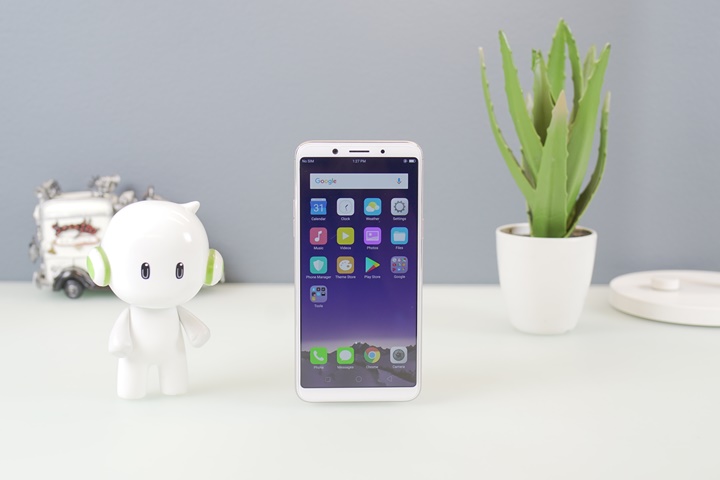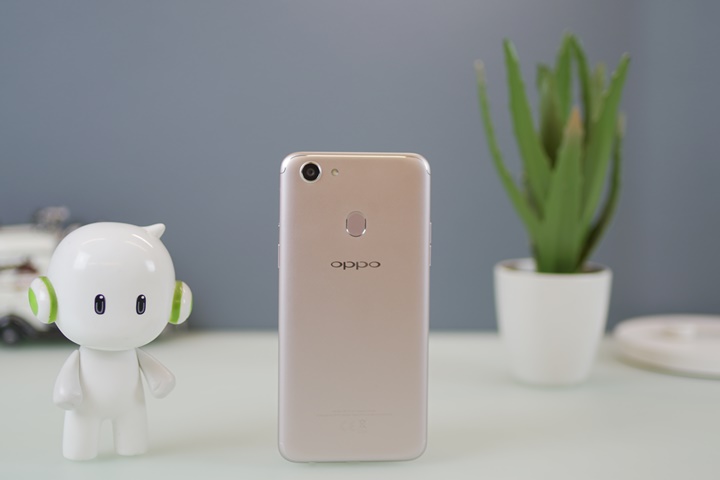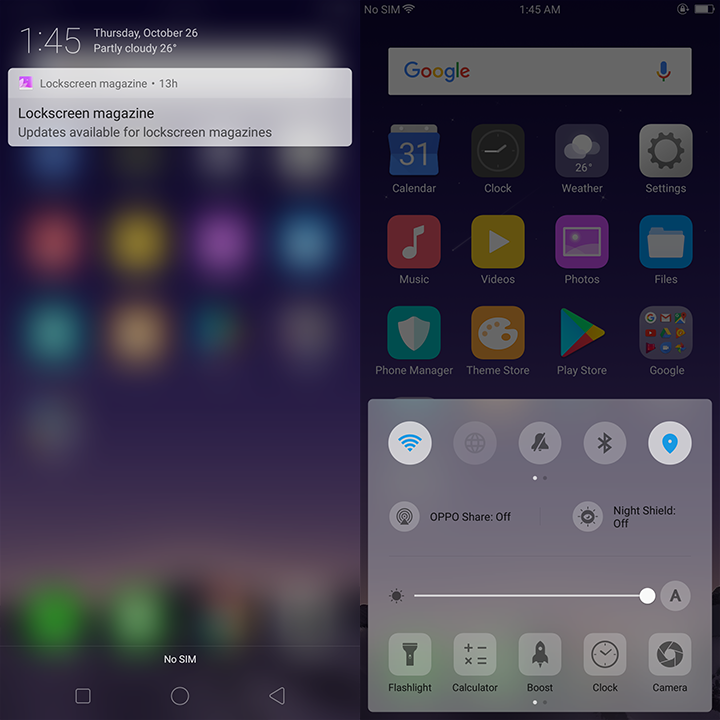In this current meta of smartphones that put top priority on their front-facing cameras, OPPO has put their eggs in the AI basket to up the selfie game of their latest smartphone, the OPPO F5. Aside from that, let’s see what else the F5 shows up at the party with.

You can also check out our hands-on video below.
The upfront appearance of the F5 makes it conform to 2017 design standards; a large 18:9 display with slim bezels, curved edges, a rear-mounted fingerprint scanner, and a metal plastic unibody chassis (the coating is that good that we initially thought its metal). It shapes up as what is probably OPPO’s sleekest smartphone to date.

The front panel is home to a 6-inch FHD+ display with an 18:9 aspect ratio, the call speaker, and the device’s primary weapon; the 20MP front camera that comes equipped with OPPO’s very own AI Beautification technology. Mounted on top is Gorilla Glass.

Moving to the back, you will see the 16MP rear camera, LED flash, and the dedicated fingerprint scanner. A pair of antenna bands can also be noticed at the top and bottom.

The left side houses the volume buttons, while the right side has the power/lock button and the triple card tray meaning it can house two nano-sized SIMs and a microSD card.

Down at the bottom are the loudspeaker, micro USB port, main microphone, and headphone jack. In terms of port selection, this is the portion where the company foregoes a very important 2017 standard, as OPPO still opted for a micro USB port instead of the newer Type C.

The overall appearance of the F5 is very nice, and its curved edges, weight, and comfortable button layout make it feel great in hand.

The device has a 6-inch 18:9 IPS display with a resolution of 2160 x 1080, which makes for a pixel density of 402ppi. It’s crisp, colors pop just right, viewing angles are good, and it’s certainly bright enough for outdoor operations.

As for the speaker, we were quite impressed as audio playback was not only loud and clear, it had a good amount of bass, especially for a smartphone loudspeaker. It’s definitely good for listening to music, watching movies, and of course hands-free calls.

Running the software department is Android 7.1.1 Nougat with OPPO’s very own ColorOS 3.2 on top.

It takes a simple and clean approach to Android, trading an app drawer for multiple home screens, as well as keeping simple icons, a stylish notification, and control screens.

Pre-installed apps include a Phone Manager app, which is a one-stop shop for your device optimization needs, proprietary standard utilities, the Google suite of apps, and Facebook. All in all, it leaves the user with 22.1GB of usable space from the 32GB.

One of the main features of the OPPO F5 is its camera. It has a 16MP rear shooter and a 20MP front for selfies. It’s packed with features like HDR, Timelapse, Panorama, Expert (Manual) with Ultra HD mode, 2x digital zoom, filters, watermark, and Beauty. The front camera has its exclusive features specifically Depth effect and Screen flash.

Performance-wise, the 16MP rear camera can produce photos that are crisp with rich yet vibrant colors and good dynamic range, especially if you’re shooting outdoors. Autofocus locks in quick even in dim environments. Low-light performance is decent with noticeable noise.
As for the 20MP front camera, OPPO equipped it with a new technology called AI Beautification. Instead of your standard face detection, the OPPO F5’s front camera can detect more than 200 points on a user’s face including the eyes, cheeks, nose, and lips to identify which parts need enhancing. OPPO then uses its database of facial features to make the necessary adjustments for a more natural result.

OPPO emphasizes that the database is from OPPO’s own R&D and that the F5 doesn’t store or send out any user information like photos or facial features. OPPO says they will push updates to the F5 as their database improves.
Now for its performance, the F5’s selfie camera does a good job in implementing its Beauty features. It now has an Auto mode in addition to Levels 1 to 6. The feature is effective as it was able to remove blemishes and wrinkles. It’s more subtle so it won’t look like someone overused the healing brush in Photoshop.

The depth effect also performs well and works best as long as there’s a significant distance between the subject and the background (best with at least 3 feet distance). The blur is still artificial but only noticeable when you zoom-in in the photo. Image quality is good with lots of details and accurate colors. It’s also good at exposing the subject well even when shooting against the light, as well as in shooting in dim conditions granted that you keep your hands steady to avoid blur.
As for video recording, both the rear and front cameras can shoot at Full HD (1920 x 1088) at 30fps in MP4 format. Quality is good with lots of details and high dynamic range, although the rear camera’s autofocus is a bit jittery, while the front can consistently lock on the subject’s face.
And that’s about it for our in-depth hands-on of the OPPO F5. Stay tuned for our full review next week.
OPPO F5 specs:
6-inch FHD+ (2160 x 1080) display, 402ppi, Gorilla Glass 5
2.50GHz MediaTeK MT6763V/CT octa-core CPU
Mali-G71 GPU
4GB RAM
32GB storage
microSD card support (dedicated slot)
16MP f/1.8 rear camera w/ LED flash
20MP f/2.0 front camera with AI Beautification Technology, screen flash
Dual-SIM (nano)
4G LTE
WiFi
Bluetooth
GPS, A-GPS
Gyroscope
microUSB
Fingerprint scanner
Face Unlock
ColorOS 3.2 (Android 7.1.1 Nougat)
3,200mAh battery
The OPPO F5 is priced at Php 15,990USD 272INR 23,099EUR 260CNY 1,984 and is now up for pre-order starting tomorrow, October 27, until November 3rd. Those who pre-order will receive a free OLike speaker worth Php 2,990USD 51INR 4,319EUR 49CNY 371. It’ll also be available under Smart Postpaid Plan 599 for 24 months starting November and under Globe Plans starting December. The phone will be available nationwide on November 4.

YugaTech.com is the largest and longest-running technology site in the Philippines. Originally established in October 2002, the site was transformed into a full-fledged technology platform in 2005.
How to transfer, withdraw money from PayPal to GCash
Prices of Starlink satellite in the Philippines
Install Google GBox to Huawei smartphones
Pag-IBIG MP2 online application
How to check PhilHealth contributions online
How to find your SIM card serial number
Globe, PLDT, Converge, Sky: Unli fiber internet plans compared
10 biggest games in the Google Play Store
LTO periodic medical exam for 10-year licenses
Netflix codes to unlock hidden TV shows, movies
Apple, Asus, Cherry Mobile, Huawei, LG, Nokia, Oppo, Samsung, Sony, Vivo, Xiaomi, Lenovo, Infinix Mobile, Pocophone, Honor, iPhone, OnePlus, Tecno, Realme, HTC, Gionee, Kata, IQ00, Redmi, Razer, CloudFone, Motorola, Panasonic, TCL, Wiko
Best Android smartphones between PHP 20,000 - 25,000
Smartphones under PHP 10,000 in the Philippines
Smartphones under PHP 12K Philippines
Best smartphones for kids under PHP 7,000
Smartphones under PHP 15,000 in the Philippines
Best Android smartphones between PHP 15,000 - 20,000
Smartphones under PHP 20,000 in the Philippines
Most affordable 5G phones in the Philippines under PHP 20K
5G smartphones in the Philippines under PHP 16K
Smartphone pricelist Philippines 2024
Smartphone pricelist Philippines 2023
Smartphone pricelist Philippines 2022
Smartphone pricelist Philippines 2021
Smartphone pricelist Philippines 2020
Marvin says:
Love the front, not a fan of the back :)
Ejia says:
Good on them for including a dedicated MicroSD slot. The F1s had one, but then they took it away for the F3.
Jude says:
USB type C has advantages over the old micro USB. IT’s only reversible but you can also plug it in to many sorts of devices and appliances that has this port and have control.
However, USB type C has still some issues. Some manufacturers do not follow the standard pin out of USB-C that is why some USB-C cables damage the gadgets. Plus, the cable itself pulls so much power from the source to charge up high powered gadgets thus, damaging the source and gadgets (unless the cable has a 56kohm resistor inside it, it will protect the source and device). But fear not since there are some USB-C cables that are manufactured using the standards. Though these branded cables do not come in cheap. The cheapest is pegged at 500 and goes to more than 2k.
That’s why I’m less into USB-C. Unless some manufacturers of this type of cable follow the standards, I will have reservations.
So, it’s really ok to find a micro USB port on some devices like in this OPPO F5.